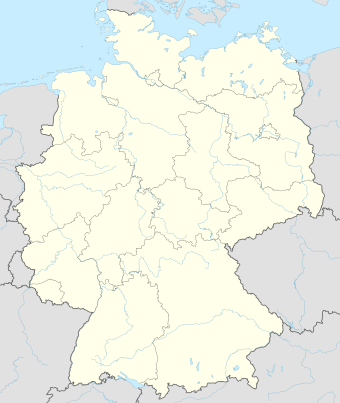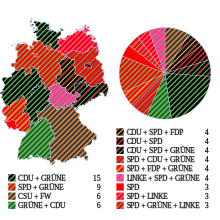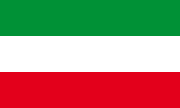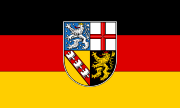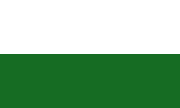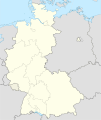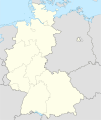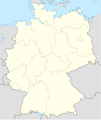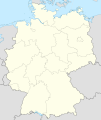Country Germany)
A Country (official name in the law - and legal jargon , in common parlance often state called) is after the federal constitutional the trim Federal Republic of Germany one of its part sovereign constituent states . The Federal Republic of Germany has consisted of 16 countries since 1990. According to the Basic Law, the federal states together form a sovereign federal state , not a loose confederation of states .
Constitutional law
According to jurisprudence and the prevailing view in jurisprudence, the states have original state power and thus state quality . Their statehood and fundamental decision-making authority is based on Article 30 of the Basic Law for the Federal Republic of Germany . They differ from ordinary states but the fact that their (partial) international legal personality from that of the Federal them so far "derived [= derivatively] and is not original" and "by the Federal Constitutional powers granted in foreign affairs." Accordingly, the countries of contracts complete with other subjects of international law, but usually only with the consent of the federal government and in providing for the legislation responsible are. Previously existing international treaties such as the Saline Convention between Bavaria and Austria of 1829 do not conflict with this. Rather, the states are bound directly or as successor states - such as in the case of the Prussian Concordat - to old international treaties .
The Federal Republic can be seen as the constitutional connection of its countries, so it is a federal state in the true sense ( Art. 20 GG ). Accordingly, it is only through this connection between its member states that the federal government itself acquires the character of a state.
politics
Political system
Politically, the Federal Republic of Germany is divided into 16 federal states. The heads of state or government of all German states parliamentary republics . The constitutional political framework of this form of government is mandatory through federal constitutional law , the so-called homogeneity requirement of the Basic Law ( Art. 28 GG ), whereby this requirement would in principle also allow a presidential form of government at the state level.
Corresponding constitutional bases can be found in the section “The Federation and the States”, Articles 20–37 of the Basic Law .
The countries in the European Union
In addition to the federal government and the German Bundestag , the states are an important actor in the political decision-making process - this also applies to German European policy . The countries are integrated into the political system of the European Union through a large number of structures and institutions . The right to participate is legally secured by the treaties ( EUV and TFEU ), the Basic Law and individual accompanying laws.
In recent years, the countries have adapted to the progressive European integration and created or expanded corresponding structures: In most countries, European ministers coordinate the country's European policy. Separate departments or units have been set up in the line ministries that deal exclusively with European dossiers. Each country has now set up its own representation in Brussels . The state parliaments have set up European committees. State parliament administrations such as in Bavaria , Baden-Württemberg and Hesse send their own officials to Brussels to monitor current developments. Through all of these measures, the countries have been able to secure and selectively expand their influence on European policy decisions. The federal states jointly maintain the establishment of the federal state observer at the European Union , who has the task of supporting the federal states and the German Bundesrat in the exercise of their tasks and rights in EU matters.
The Lisbon Treaty , which has been in force since December 1, 2009, strengthens the right of the countries to represent their country-specific interests vis-à-vis the European institutions. For the first time, local self-government , divided into local communities and supra-local districts, is recorded in primary law . The principle of subsidiarity guarantees that the countries are responsible for all those areas which they can best achieve themselves and which do not fall under the exclusive competence of the European Union (EU). In disputes about compliance with the principle of subsidiarity and the protection of their own institutional rights, the countries can refer to the European Court of Justice through the Committee of the Regions (CoR) .
Framework data of the countries

Official or own names
In addition to eleven members of the federal government , which officially designate themselves as the state , three (Bavaria, Saxony and Thuringia) Free State are part of the name and two other member states, Free Hanseatic City of Bremen and Free and Hanseatic City of Hamburg, the name of the state (designation in legal transactions ).
Apart from own names in the minority languages Danish (Schleswig-Holstein: Delstat Slesvig-Holsten ), Frisian (Schleswig-Holstein: Lönj Slaswik-Holstiinj ), Lower Sorbian (Brandenburg: Kraj Bramborska ) and Upper Sorbian (Saxony: Swobodny stat Sakska ) there are also names some countries in Low German .
politics
| coat of arms | country | Abbreviation | capital city | most populous city a |
Accession to the federal government |
Head of government |
Governing party (s) |
Federal Council votes |
Area (km²) |
Check- residents (million) |
Mono- inhabitants per km |
Foreigners (%) |
languages |
|---|---|---|---|---|---|---|---|---|---|---|---|---|---|
|
|
Baden-Wuerttemberg | BW | Stuttgart | 1949 | Winfried Kretschmann ( Greens ) | Greens and CDU | 6th | 35,748 | 11.070 | 310 | 15.5 | German | |
|
|
Bavaria | BY | Munich | 1949 | Markus Söder ( CSU ) | CSU and Free Voters | 6th | 70,542 | 13,077 | 185 | 13.2 | German | |
|
|
Berlin | BE | - | 1990 | Michael Müller ( SPD ) | SPD , Left and Greens | 4th | 891 | 3,645 | 4090 | 18.5 | German | |
|
|
Brandenburg | BB | Potsdam | 1990 | Dietmar Woidke (SPD) | SPD , CDU and Greens | 4th | 29,654 | 2.512 | 85 | 4.7 | German, Lower Sorbian , Low German | |
|
|
Bremen | HB |
Bremen ( de facto ) |
1949 | Andreas Bovenschulte (SPD) | SPD , Greens and Left | 3 | 419 | 0.683 | 1629 | 18.1 | German, Low German | |
|
|
Hamburg | HH | - | 1949 | Peter Tschentscher (SPD) | SPD and Greens | 3 | 755 | 1,841 | 2438 | 16.4 | German, Low German | |
|
|
Hesse | HE | Wiesbaden | Frankfurt am Main | 1949 | Volker Bouffier ( CDU ) | CDU and Greens | 5 | 21,116 | 6.266 | 297 | 16.2 | German |
|
|
Mecklenburg-Western Pomerania | MV | Schwerin | Rostock | 1990 | Manuela Schwesig (SPD) | SPD and CDU | 3 | 23,295 | 1.610 | 69 | 4.5 | German, Low German |
|
|
Lower Saxony | NI | Hanover | 1949 | Stephan Weil (SPD) | SPD and CDU | 6th | 47,710 | 7.982 | 167 | 9.4 | German, Sater Frisian , Low German | |
|
|
North Rhine-Westphalia | NW | Dusseldorf | Cologne | 1949 | Armin Laschet (CDU) | CDU and FDP | 6th | 34,112 | 17.933 | 526 | 13.3 | German, Low German |
|
|
Rhineland-Palatinate | RP | Mainz | 1949 | Malu Dreyer (SPD) | SPD , Greens and FDP | 4th | 19,858 | 4.085 | 206 | 11.1 | German | |
|
|
Saarland | SL | Saarbrücken | 1957 | Tobias Hans (CDU) | CDU and SPD | 3 | 2,571 | 0.991 | 385 | 11.1 | German | |
|
|
Saxony | SN | Dresden | Leipzig | 1990 | Michael Kretschmer (CDU) | CDU , Greens and SPD | 4th | 18,450 | 4.078 | 221 | 4.9 | German, Upper Sorbian |
|
|
Saxony-Anhalt | ST | Magdeburg | Halle (Saale) | 1990 | Reiner Haseloff (CDU) | CDU , SPD and Greens | 4th | 20,454 | 2.208 | 108 | 4.9 | German, Low German |
|
|
Schleswig-Holstein | SH | Kiel | 1949 | Daniel Günther (CDU) | CDU , Greens and FDP | 4th | 15,804 | 2.897 | 183 | 8.0 | German, Danish, North Frisian , Low German or Low German and Romanes | |
|
|
Thuringia | TH | Erfurt | 1990 | Bodo Ramelow ( left ) | Left , SPD and Greens | 4th | 16.202 | 2.143 | 132 | 4.9 | German | |
|
|
Federal Republic of Germany (DE) | DE | Berlin | - | Angela Merkel (CDU) | CDU / CSU and SPD | b - | 357,582 | 83.019 | 232 | 12.2 | German (official language) and the recognized minority languages in the individual countries |
|
- As of May 19, 2021.
- The population figures are extrapolations rounded to the nearest thousand by the Federal Statistical Office - uniform for December 31, 2018.
- aIn five of the 16 federal states, the most populous city is not the state capital. The state capital is the second most populous city in each of these countries.
- bThe federal government has no votes in the Bundesrat , the total number of votes in all states is 69.
business
| coat of arms | country |
GDP (2018) in billion euros |
Per capita (2018) in € |
EK / K in € |
Debt (2012) in billions of euros |
Per capita (2012) in € |
Debt (December 31, 2018) in billions of euros |
Per capita (December 31, 2018) in € |
AQ |
|---|---|---|---|---|---|---|---|---|---|
|
|
BW | 511.4 | 46.279 | 19,261 | 67.471 | 6,255 | 44.009 | 3,976 | 3.9 |
|
|
BY | 625.2 | 47,946 | 18,775 | 42.794 | 3,397 | 14.613 | 1,117 | 3.8 |
|
|
BE | 147.1 | 40,568 | 14,797 | 61.220 | 17,482 | 54,403 | 14,926 | 9.8 |
|
|
BB | 73.7 | 29,411 | 14,634 | 21,336 | 8,549 | 16,122 | 6,418 | 8.2 |
|
|
HB | 34.3 | 50,389 | 19,933 | 19,660 | 29,729 | 21.730 | 31,816 | 10.5 |
|
|
HH | 120.3 | 65,603 | 22,908 | 24.256 | 13,484 | 34,362 | 18,663 | 7.2 |
|
|
HE | 292.0 | 46,719 | 18,658 | 55.497 | 9.110 | 40.396 | 6,447 | 5.4 |
|
|
MV | 44.9 | 27,905 | 13,953 | 12,222 | 7,476 | 7.653 | 4,754 | 10.3 |
|
|
NI | 296.2 | 37,118 | 17,105 | 69.557 | 8,790 | 58.718 | 7,356 | 6.2 |
|
|
NW | 705.1 | 39,358 | 18,724 | 237.497 | 13,311 | 167.167 | 9,322 | 7.7 |
|
|
RP | 149.1 | 36,573 | 17.101 | 44.097 | 11,027 | 30.637 | 7,500 | 5.4 |
|
|
SL | 36.0 | 36,243 | 17,138 | 16.015 | 15,804 | 13.812 | 13,944 | 7.2 |
|
|
SN | 126.4 | 31,008 | 14,599 | 9,600 | 2,320 | 1.409 | 346 | 7.5 |
|
|
ST | 63.5 | 28,685 | 14.005 | 24,330 | 10,518 | 19,932 | 9,026 | 9.8 |
|
|
SH | 97.1 | 33,555 | 16,920 | 31,314 | 11,035 | 30.913 | 10,672 | 6.6 |
|
|
TH | 63.8 | 29,739 | 14,152 | 18.925 | 8,520 | 14,646 | 6,834 | 7.0 |
|
|
DE | 3,386.0 | 40,851 | 17,702 | 1,286.190 | 15,715 | 1,213,217 | 14,613 | 6.6 |
|
|
EU | 23,100 | 6.3 | ||||||
Official names and flags of the German states

|
State of Baden-Württemberg Aspect ratio: 3: 5 |
Free State of Bavaria 3: 5 |
State of Berlin 3: 5 |
State of Brandenburg 3: 5 |
|
Free Hanseatic City of Bremen 2: 3 |
Free and Hanseatic City of Hamburg 2: 3 |
State of Hesse 3: 5 |
State of Mecklenburg-Western Pomerania 3: 5 |
|
State of Lower Saxony 2: 3 |
State of North Rhine-Westphalia 3: 5 |
State of Rhineland-Palatinate 2: 3 |
Saarland 3: 5 |
|
Free State of Saxony 3: 5 |
State of Saxony-Anhalt 3: 5 |
State of Schleswig-Holstein 3: 5 |
Free State of Thuringia 1: 2 |
The national flags of the countries are shown here. They can be shown in public by any citizen. The state service flags, on the other hand, are severely restricted in their use - they may only be used by the respective state authorities.
The Free State of Bavaria has two equivalent state flags: one is the flag shown here with horizontal stripes in the colors white and blue, and the other is a white and blue diamond (→ State flag of Bavaria ).
There is no difference between the state flag and the state service flag in the following countries: Bavaria, Berlin, Brandenburg, Hamburg, Lower Saxony, Rhineland-Palatinate and Saarland. The Bremen state flags with coats of arms (in two variants) may also be used by the citizens.
The state service flags of the following states also show the state coat of arms: Baden-Württemberg, Hesse, North Rhine-Westphalia, Saxony, Saxony-Anhalt, Schleswig-Holstein, Thuringia. The state service flag of Mecklenburg-Western Pomerania shows the heraldic figures of Mecklenburg and Pomerania without a coat of arms.
Breakdown of the countries
The city-states Berlin and Hamburg are each a state and a city at the same time and are therefore not further subdivided into municipalities ; the local and supra- local levels coincide. The state of Bremen consists of the independent cities of Bremen and Bremerhaven . In the other German states there are the following administrative and self-government units:
- Administrative districts : The large states of Baden-Württemberg, Bavaria, Hesse and North Rhine-Westphalia are divided into administrative districts. The districts are decentralized units of the state administration. The subdivision of the states of Lower Saxony (until 2004), Rhineland-Palatinate (until 1999), Saxony-Anhalt (until 2003) and Saxony (until 2012) has been removed. In Rhineland-Palatinate, the three regional councils were replaced by two structure and approval directors and one supervisory and service directorate. The Palatinate region also has the Palatinate District Association, which was established at the beginning of the 19th century . Landscape associations also exist in North Rhine-Westphalia and Lower Saxony . In Saxony, where the administrative districts were converted into so-called regional directorates in 2008 , the central authorities were abolished in favor of a new higher regional authority, the regional directorate Saxony .
- Counties and urban districts : Each state is divided into counties (referred to as counties in North Rhine-Westphalia and Schleswig-Holstein ). Overall, there are 295 counties in the Federal Republic of Germany (including the cities of Aachen , the Hannover Region and the Regional Association Saarbrücken ). In addition, there are the 107 independent cities (including the two independent cities in Bremen) that do not belong to any district, but perform the tasks of the districts themselves, insofar as they form a separate district . Therefore they were in the East German states until 1994 and they are still called urban districts in Baden-Württemberg today. The districts are local authorities that have directly elected bodies .
- Municipal associations : In some countries, as an intermediate stage of municipal work between the district and the municipalities, there are municipal associations or administrative communities in different forms and with different tasks. They therefore have very different names depending on the country, e.g. B. Office (BB, MV, SH), Samtgemeinde (NI), Verbandsgemeinde ( RP , ST ) or Municipal Administration Association (BW) (see overall municipality ).
- Municipalities : Municipalities are the smallest independent territorial units. In Germany there are currently 12,320 municipalities and 248 municipality-free areas (as of March 1, 2006). Cities are usually municipalities that are only allowed to use the designation city (see city law ). This is either historically guaranteed and was usually associated with numerous privileges in the Middle Ages (for example own taxes ), or it is a question of larger municipalities, which are given the name of town again due to their current importance and tasks (depending on the country, this is very much handled differently). For the capital of a country, the designation state capital has established itself . The municipalities are also regional authorities with directly elected bodies.
History of the German states from 1945
For the federal members of the German Empire, see the structure of the German Empire 1871–1918
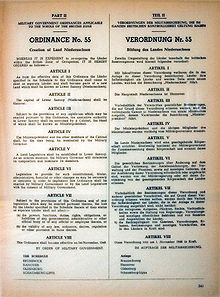
While the principle of federalism in Germany and thus its composition of countries goes back to the Middle Ages, the specific structure, the individual countries, was repeatedly subject to major breaks in continuity: The Holy Roman Empire counted over 300 territories, some of them tiny, in 1792, the German Confederation in 1815 in the same area only 38; 25 of them founded in 1871, the new German Empire , were in 1918 as the overall State Republics and 1934, the Nazi Gleichschaltung policy reduced to administrative units - the countries now had their constituent state almost entirely lost character.
The territorial reorganization of Germany into countries by the Allies after 1945 only partially followed on from the old structures; they are a result that has been created in a purposeful manner and ignores historical and national contexts. Many countries are completely new creations. In particular, the overpowering Prussia was dissolved and some of its provinces were converted into independent countries. The boundaries of the zones of occupation were decisive for the layout of the newly founded states : with the exception of the former capital of Berlin, each state and its entire territory were subject to a single occupying power .
The territories of the occupied German Reich were divided and the first countries were founded in July 1945 in the Soviet zone of occupation . However, for a future Germany (without Austria, which had again become a state), the Soviets pursued the draft of a centralized state in which the states were merely to represent administrative units . This was opposed by the concept of a federal state preferred by the Americans in particular , in which the countries should also play an important political role.
Due to the "Proclamation No. 2" on September 19, 1945, the first countries with this orientation emerged in the US occupation zone. As of January 21, 1947, there were 16 states within the four zones of occupation in what is now the Federal Republic of Germany, which were essentially made up of the following areas:
-
American zone of occupation :
- Bavaria: Main part of the state of Bavaria, whereby the district of Lindau (Lake Constance) including the city of Lindau , which was independent from September 25, 1948 , belonged to the French occupation zone
- Bremen: State of Bremen (although it was enclosed as an exclave by British occupation, but the Americans claimed a seaport for their supply)
- Hesse ( Greater Hesse ): Main part of the People's State of Hesse , main part of the Prussian Province of Hesse-Nassau
- Württemberg-Baden : Northern part of the state of Württemberg, northern part of the state of Baden
-
British Zone of Occupation :
- Hamburg: State of Hamburg
- Lower Saxony: Lands of Hanover (re-established as an independent state after being part of Prussia in the meantime as the Province of Hanover 1866–1946), Braunschweig , Oldenburg and Schaumburg-Lippe
- North Rhine-Westphalia (by Military Ordinance No. 46 of August 23, 1946): North Rhine or the northern part of the Prussian Rhine Province (administrative districts of Aachen , Düsseldorf and Cologne ), the Prussian Province of Westphalia and the State of Lippe (subsequent incorporation by Military Ordinance No. 77 of January 21, 1947)
- Schleswig-Holstein: Prussian Province of Schleswig-Holstein
-
French occupation zone :
- Baden : southern part of the state of Baden
- Rhineland-Palatinate: southern part of the Prussian Rhine province (administrative districts Koblenz and Trier ), western part of the Prussian province of Hesse-Nassau (→ Province of Rhineland-Hesse-Nassau ), south-western part of the state of Hesse ( Rheinhessen ), Bavarian Palatinate
- Württemberg-Hohenzollern : southern part of the state of Württemberg, Prussian exclave Hohenzollern, district of Lindau (Lake Constance) including the city of Lindau (Lake Constance), which was independent from September 25, 1948
-
Soviet occupation zone (→ Land (GDR) ):
- Brandenburg : Prussian province of Brandenburg west of Oder and Lusatian Neisse
- Mecklenburg : State of Mecklenburg, Western Pomerania (western part of the Prussian province of Pomerania )
- Saxony: State of Saxony, part of the Prussian province of Lower Silesia to the west of the Neisse
- Saxony-Anhalt: Main part of the Prussian province of Saxony , Land Anhalt
- Thuringia: State of Thuringia , administrative district Erfurt (southern part of the Prussian province of Saxony)
- As a divided city , Berlin , the German capital, was subject to the four- power statute and, corresponding to its four-power status, was the seat of the Allied Control Council in Germany .
- In January 1946, the Saarland was removed from the area of responsibility of the Control Council and received its own constitution in 1947 as the Saar Protectorate .
chronology
On August 23, 1946, through ordinance No. 46 of the British military government for the "dissolution of the provinces of the former Prussia in the British zone and their re-establishment as independent states", the states of Hanover (later with the states of Braunschweig, Oldenburg and Schaumburg-Lippe merged to form Lower Saxony), North Rhine-Westphalia and Schleswig-Holstein. Hamburg remained an independent country. The state of Rhineland-Palatinate was also created in 1946 by decree of the French military government.
In 1947 the former land of Lippe had to give up its independence at the instigation of the British occupying forces. After negotiations with the two neighboring states of Lower Saxony and North Rhine-Westphalia, the Lippe government decided to join the latter. In the Lippe punctuation , the governments of Lippe and North Rhine-Westphalia agreed to take Lippe's interests into account in the future. On January 21, 1947, the Association came into effect through British Military Ordinance No. 77. According to this ordinance, a new structure could have been ordered after a referendum to be held within five years , but this was not done. On November 5, 1948, the incorporation was finally legally regulated with the “Law on the Unification of the State of Lippe with North Rhine-Westphalia” by the North Rhine-Westphalian state parliament.
The Hessian constitution was passed by the state assembly in Wiesbaden on October 29, 1946, entered into force on December 1, 1946 through a referendum, making it Germany's first post-war constitution. This was followed by the Constitution of the Free State of Bavaria , which was adopted in a referendum on December 1, 1946 .
On February 25, 1947, the Allied Control Council resolved to dissolve Prussia by means of Control Council Act No. 46 . Until then existed Free State of Prussia still continuing with its provinces so far as Brandenburg and Saxony-Anhalt in the Soviet occupation zone were referred in their first constitutions not as a country but as provinces, while about for the country education in the British zone (see. Above ) as early as 1946 there was express mention of the dissolution of the Prussian provinces. On February 28, 1947, the state constitution of Saxony was passed.
On May 23, 1949, the Basic Law for the Federal Republic of Germany was promulgated. The states of Schleswig-Holstein, Lower Saxony, Hamburg, Bremen, North Rhine-Westphalia, Rhineland-Palatinate, Hesse, Württemberg-Baden, Baden, Württemberg-Hohenzollern and Bavaria joined the scope of the Basic Law. Berlin (West) always had a special status - also according to the Four Power Agreement - even if it was regarded as a federal state (" Greater Berlin ") under Article 23 of the Basic Law (old version ).
As the first structural reform since the founding of the Federal Republic of Germany, Baden, Württemberg-Baden and Württemberg-Hohenzollern were united to form the state of Baden-Württemberg on April 25, 1952.
In the same year, the states in the GDR were not formally dissolved, but they were relieved of their state powers, which was tantamount to a de facto dissolution; 14 districts took their place . The law did not affect the eastern sector of Berlin , which itself was not part of the GDR. Only a decree of the State Council of the GDR from 1961 officially assigned "Berlin", the sense of East Berlin, the status of a district as the "Capital of the German Democratic Republic".
Saarland , which has been nominally independent since 1947 , entered the area of application of the Basic Law of the Federal Republic of Germany on January 1, 1957 after a referendum - whether as the tenth or eleventh country depends on how one retrospectively assesses the internationally controversial and constitutionally complicated status of West Berlin . According to the state constitution , "the Saarland [henceforth] is a democratically and socially organized federal state." The one-sided economic union between the Saarland and France lasted until 1959.
After Baden-Württemberg was founded in April 1952.
January 1957 - October 1990, after Saarland joined the Federal Republic.
After the unification of Germany on October 3, 1990.
Southwest state
After the Second World War , the northern parts of Baden and Württemberg came under the American occupation zone, the southern parts and Hohenzollern under the French . The military governments of the zones of occupation founded the states of Württemberg-Baden in the American zone and Württemberg-Hohenzollern and Baden in the French zone in 1945/46 . These countries became part of the Federal Republic of Germany on May 23, 1949.
On December 9, 1951, the referendum on the founding of Baden-Württemberg took place. In the vote, voters in both parts of Württemberg voted with 93% for the merger, in North Baden with 57%, while in South Baden only 38% were in favor. In three out of four voting districts there was a majority in favor of the formation of the south-west state, so that the formation of a south-west state was decided. Thereupon the states were united on April 25, 1952 and the state of Baden-Württemberg was founded.
The five "new countries"
In July 1990, the Land Introduction Act was passed, which abolished the districts in the GDR and reestablished the five states that had been deprived of power in 1952 in favor of the districts (Mecklenburg was given back the name Mecklenburg-Western Pomerania , which it had already had from 1945 to 1947).
The law came into force on October 3, 1990, making them, like Berlin, the western part of which was “not a constitutive part of the Federal Republic” due to the allied right of reservation ( four-sector city ), states of the Federal Republic of Germany. The internal borders between the new federal states were redefined when the new federal state was built.
Discussions on the reorganization of the federal territory after 1952 and 1990
A reorganization of the federal territory based on Article 29 of the Basic Law was repeatedly brought into the political discussion in the "old" states after 1952 and in the "new" states, including Berlin, after 1990.
Merger initiatives
In 1996 a merger of Berlin and Brandenburg sought by the two state governments failed due to the rejection of the Brandenburg population. Although Art. 118a of the Basic Law would explicitly allow for simplified merger regulations, the procedure according to Art. 29 was used for political reasons .
The unification of two federal states or other territorial changes, such as separation or partial reclassifications (according to Art. 29 Paragraphs 2 and 3 as well as the federal referendum according to Art. 29 Paragraph 4 GG) are the only specifically cited case (except for Art. 146 , new constitution) , in which the Basic Law provides for a referendum.
Separation Initiatives
In addition to mergers, divisions are also discussed. On January 19, 1975, a referendum took place in the former states of Oldenburg and Schaumburg-Lippe in order to restore them. Although a majority of the voters voted for a separation of their areas from Lower Saxony , the German Bundestag did not follow this vote. The Federal Constitutional Court confirmed the point of view of the MPs. The existing since 1991 under this name " Frankish Bund " calls for secession franc from the State of Bavaria. In Baden , a "State Association of Baden in Europe" has been advocating the interests of Baden and its former state capital Karlsruhe and against too much centralism on the part of Stuttgart since 1992 .
Since the Federal Constitutional Court sees the meaning of Art. 29 GG according to the "Oldenburg judgment" in the fact that a regional reorganization should result in more efficient countries with less administrative effort, it is questionable whether the number of countries can be increased through referendums .
Comparison of the country structure of the Weimar Republic and the Federal Republic of Germany
area
| Area in km² |
Weimar Republic |
Federal Republic of Germany |
|---|---|---|
| > 250,000 | 1 | 0 |
| 50,000-100,000 | 1 | 1 |
| 20,000-50,000 | 0 | 7th |
| 10,000-20,000 | 5 | 4th |
| 5,000-10,000 | 2 | 0 |
| 2,000-5,000 | 3 | 1 |
| 1,000-2,000 | 3 | 0 |
| <1,000 | 4th | 3 |
resident
| Population (1925 and 2018) | Weimar Republic |
Federal Republic of Germany |
|---|---|---|
| > 30,000,000 | 1 | 0 |
| 10,000,000-20,000,000 | 0 | 3 |
| 5,000,000-10,000,000 | 1 | 2 |
| 2,000,000-5,000,000 | 3 | 7th |
| 1,000,000-2,000,000 | 3 | 2 |
| 500,000-1,000,000 | 4th | 2 |
| 100,000-500,000 | 5 | 0 |
| <100,000 | 2 | 0 |
(In the "Weimar Republic" columns, the Saar area was counted as one country.)
Statistics on German countries
- according to unemployment rate
- by at-risk-of-poverty rate
- after spending on research and development
- according to population
- according to population density
- according to gross domestic product
- according to household income
- after exports
- according to fertility rate
- by area
- according to HDI (human development index)
- according to state budget
- according to life expectancy
- after tax receipts
- according to suicide rate
- after debt
See also
- Political system of the Federal Republic of Germany
- Federalism reform
- Distribution of seats in the German state parliaments
- List of coats of arms in Germany
- ISO 3166-2: DE (standardized abbreviation)
literature
- Werner Künzel, Werner Rellecke: History of the German countries. Münster 2005, ISBN 3-402-03416-6 .
- Hans Georg Wehling: The German states. History, politics, economics. 2004, ISBN 3-531-43229-X .
- Sven Leunig: The government systems of the German states. 2nd Edition. Springer VS, Wiesbaden 2012, ISBN 978-3-531-17421-1 .
- Sven Leunig: The government systems of the German states in comparison. Budrich, Opladen 2007, ISBN 3-8252-2844-4 .
Web links
- Parliament mirror - documents of the state parliaments of the Federal Republic of Germany
- Almost all German federal states provide graphically slightly modified country logos or a country logo (link list)
- Matthias Stolz: Topology of the federal states ( ZEITMagazin 21/2021)
Remarks
- ↑ In Duden . The German spelling , ed. von der Dudenredaktion, 23rd edition, Mannheim / Leipzig / Vienna / Zurich 2004, ISBN 3-411-04013-0 , keyword: federal state , p. 250 there is no reference to the use (alone) in colloquial language ; according to Ulrich Ammon et al., German dictionary of variants. The standard language in Austria, Switzerland and Germany as well as in Liechtenstein, Luxembourg, East Belgium and South Tyrol , Walter de Gruyter, Berlin 2004, ISBN 3-11-016574-0 , p. 150 (keyword "federal state") is the word almost only in Used in connection with the demarcation between “ old ” and “ new ” federal states.
- ↑ According to the Federal Constitutional Court, they are "endowed with their own - albeit objectively limited - state sovereignty that is not derived from the federal government but recognized by it" ( BVerfGE 1, 14 (34) ). See also BVerfGE 34, 9 (19 f.); BVerfGE 36, 342 (360 f.); BVerfGE 60, 175 (207 f.).
- ↑ Ipsen, Staatsrecht I - Staatsorganisationsrecht , § 5 Rn. 21 (section "Member states of federal states and confederation of states").
- ↑ Herdegen, Staatsrecht , § 8 marginal number 30 (section “Federal State”).
- ^ Herbert Krüger , Foreign Administration , in: Die Verwaltung , ed. by Friedrich Giese, Volume 2, Issue 38, Braunschweig undated, p. 7: By Article 32.3 of the Basic Law, “the states are placed in international law and thus recognized as subject to international law, albeit limited,”. See also the Lindau Agreement on the competence disputes .
- ↑ The German federal state grants its member states a limited capacity to act under international law, according to Georg Dahm / Jost Delbrück / Rüdiger Wolfrum, Völkerrecht , Vol. I / 2, 2nd ed. 2002, p. 202 .
- ↑ The Federal Constitutional Court has decided that the states can exceptionally concordats without the consent of the federal government.
- ↑ The federal states have made good use of this option and have even occasionally joined international organizations , see Democratic Legitimation of the Activities of International Organizations (PDF; 899 kB), pp. 13 and 15 f. With further evidence.
- ↑ Cf. Dieter Hesselberger , Das Grundgesetz. Commentary for political education , 13th edition, Art. 20, marginal numbers 1, 7; Avenarius, Die Rechtsordnung , 3rd ed., P. 23 f.
- ↑ See diagram of the European coordination of the federal states from the European Movement Network in Germany
- ↑ Uwe Andersen / Wichard Woyke (ed.): Concise dictionary of the political system of the Federal Republic of Germany , 4th edition, Springer, Wiesbaden 2000, p. 187 .
- ↑ a b c Federal and State Statistical Offices : Area and Population , as of November 4, 2014, inh / km² calculated according to rounded values, as the source is partly incorrect (cf. value for Berlin). All figures rounded to the nearest whole number, accessed on May 29, 2018.
- ^ Territory and population - foreign population ( memento of November 2, 2010 in the Internet Archive ), Federal and State Statistical Offices. Retrieved December 18, 2012.
- ↑ In 1949, the former states of Baden , Württemberg-Baden and Württemberg-Hohenzollern joined the federal government, which were combined in 1952 to form what is now the state of Baden-Württemberg.
- ↑ Berlin has only been a fully fledged state since reunification , even if Berlin (West) was largely treated as such during the division (see also the Berlin question ).
- ↑ a b National accounts of the federal states - VGRdL , as of 2018
- ↑ Income per capita - Source: Baden-Württemberg State Statistical Office ( Memento of March 8, 2008 in the Internet Archive ), as of 2007
- ↑ Debt status: March 31, 2012, source: Federal Statistical Office , public debt on March 31, 2012 - preliminary result
- ↑ Calculated from the population as per Destatis as of December 31, 2011 and the level of debt as of March 31, 2012.
- ↑ a b Federal Statistical Office, debts of the federal states on December 31, 2018 (including extra budgets) , accessed on June 11, 2020, per capita debt calculated with the number of inhabitants of the federal states as of December 31, 2018 (Table 12411-0010)
- ↑ Unemployment rate in Germany by federal state (as of June 2012) , source: Federal Employment Agency
- ↑ Finances and Taxes - Debt of the General Public Budget 2018. In: Fachserie 14 Reihe 5. Federal Statistical Office, August 5, 2019, p. 68 , accessed on June 11, 2020 .
- ↑ EU28, source: Eurostat
- ↑ Eurostat (press release): November 2006: Unemployment rate in the euro area fell to 7.6%, EU25 fell to 7.7% (PDF)
- ↑ Kurt Düwell : "Operation Marriage" - British obstetrics during the founding of North Rhine-Westphalia ( Memento of December 6, 2012 in the Internet Archive ) (PDF; 91 kB), speech manuscript, Düsseldorf 2006, accessed on August 28, 2012.
- ↑ Ordinance No. 46, dissolution of the provinces of the former Land of Prussia in the British Zone and their re-establishment as independent states of 23 August 1946
- ↑ Law on the further democratization of the structure and functioning of the state organs in the countries of the German Democratic Republic of July 23, 1952
- ↑ Decree of the Council of State of the German Democratic Republic on the regulations on the tasks and functioning of the city council assemblies and the city district assemblies and their organs in the capital of the German Democratic Republic, Berlin, and the city districts with city districts of September 7, 1961 (Journal of Laws of I p . 169) ( Memento from January 11, 2010 in the Internet Archive )
- ↑ Cf. Detlev Brunner: The appearance of sovereignty. State government and occupation policy , p. 33 f.
- ↑ Hanns-Jürgen Wiegand, Direct Democratic Elements in German Constitutional History , BWV, Berlin 2010, p. 220.
- ↑ BVerfGE 49, 15 - Oldenburg referendum
- ^ Website of the Landesvereinigung Baden in Europa e. V.
